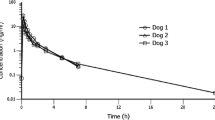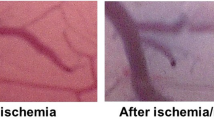Summary
Patients with subarachnoid haemorrhage (SAH) have been shown to benefit from β-blockade. SAH patients who came to surgery were investigated if they had been receiving chronic (approximately one week) oral treatment with either hydrophilic atenolol (100 mg/day) or one of the following lipophilic β-Blockers: propranolol (80 mg b.i.d.), oxprenolol (80 mg b.i.d.), or metoprolol (100 mg b.i.d.). Cerebrospinal fluid concentrations of β-Blockers did not reflect their concentrations in the brain. Brain concentrations of the three lipophilic β-Blockers were 10–20 times higher than those of atenolol. The approximate brain/plasma concentration ratios were 26 for propranolol, 50 for oxprenolol, 12 for metoprolol, and 0.2 for atenolol. The brain is thus buffered from peak blood concentrations of atenolol, and this may account for the low incidence of CNS-related side-effects with this hydrophilic β-blocker.
Similar content being viewed by others
References
Cruickshank JM, Neil-Dwyer G, Bartlett J, McAinsh J (1980) Beta-blockers and the blood-brain barrier. Primary Cardiol (Suppl 1): 34–37
Myers MG, Lewis PJ, Reid JL, Dollery CT (1975) Brain concentration of propranolol in relation to hypotensive effect in the rabbit with observations on brain propranolol levels in man. J Pharmacol Exp Ther 129: 327–335
Neil-Dwyer G, Walter P, Cruickshank JM, Doshi B, O'Gorman P (1978) Effect of propranolol and phentolamine on myocardial necrosis after subarachnoid haemorrhage. Br Med J 2: 990–992
Neil-Dwyer G, Walter P, Parsons V (1979) Phentolamine and propranolol in the treatment of subarachnoid haemorrhage. Proceedings of the Second International Workshop on Cerebral Vasospasm, Amsterdam
Neil-Dwyer G, Bartlett J, McAinsh J, Cruickshank JM (1981) β-adrenoceptor blockers and the blood-brain barrier. Br J Clin Pharmacol 11: 549–553
Street JA, Hemsworth BA, Roach AG, Day MD (1979) Tissue levels of several radiolabelled beta-adrenoceptor antagonists after intravenous administration in rats. Arch Int Pharmacodyn 237: 180–190
van Zwieten PA, Timmermans PB (1979) Comparison between the acute haemodynamic effects and brain penetration of atenolol and metoprolol. J Cardiovasc Pharmacol 1 (1): 85–96
Walter P, Neil-Dwyer G, Cruickshank JM (1982) Beneficial effects of adrenergic blockade in patients with subarachnoid haemorrhage. Br Med J 285: 1661–1664
Woods PB, Robinson ML (1981) An investigation of the comparative liposolubilities of beta-adrenoceptor blocking agents. J Pharm Pharmacol 33: 172–172
Author information
Authors and Affiliations
Rights and permissions
About this article
Cite this article
Cruickshank, J.M., Neil-Dwyer, G. β-blocker brain concentrations in man. Eur J Clin Pharmacol 28 (Suppl 1), 21–23 (1985). https://doi.org/10.1007/BF00543705
Issue Date:
DOI: https://doi.org/10.1007/BF00543705




